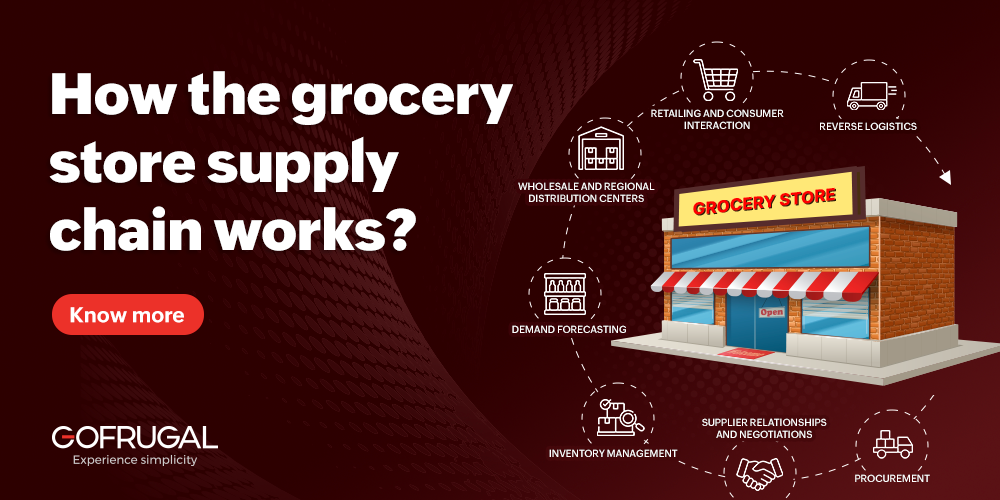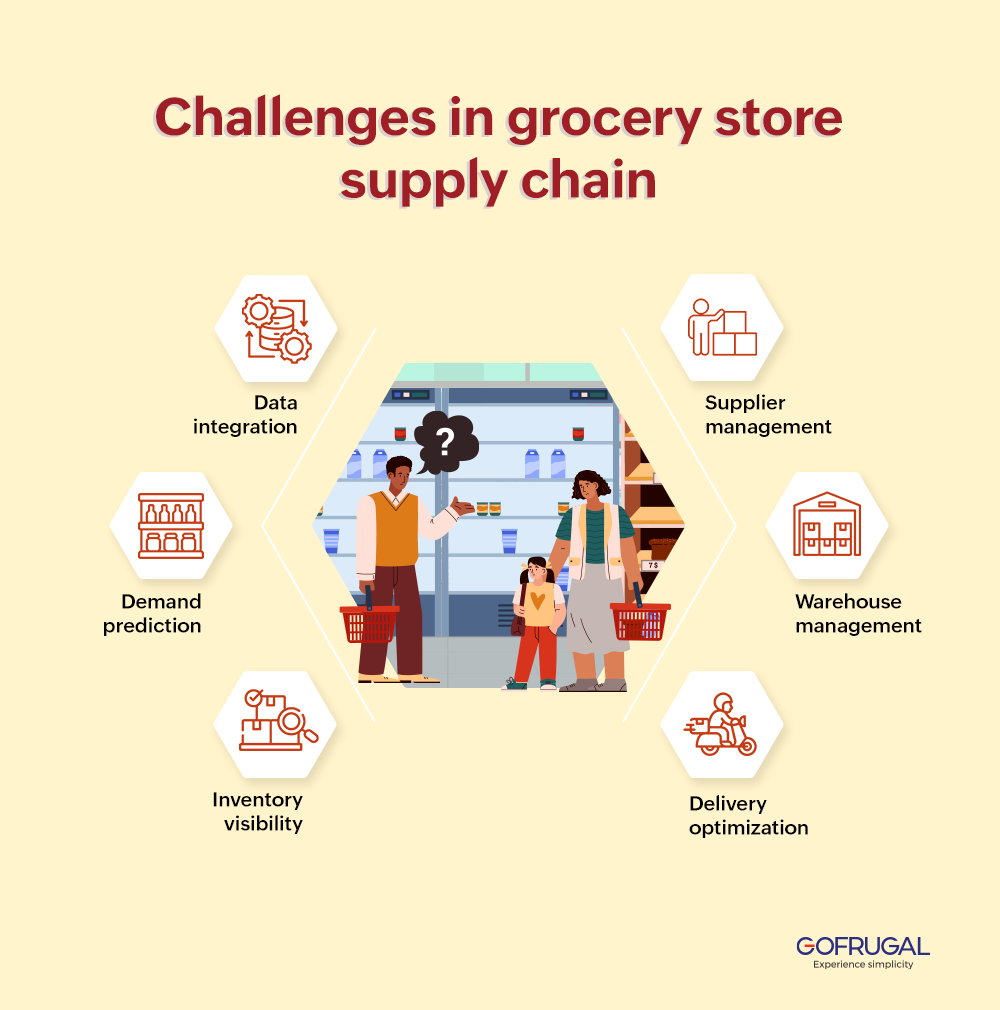Step behind the scenes of your favourite grocery store where a captivating yet intricate dance unfolds: the grocery supply chain. Pull back the curtain and explore the complexities of the grocery supply chain, including why it is vital, how it works, the challenges it faces, and transformative tips to keep your shopping experience smooth and satisfying.
What is a grocery store supply chain?
The grocery store supply chain operates like a relay race, involving interactions with product makers, stock management, and distribution center coordination. It’s a collective effort to ensure a seamless shopping experience, with key goals including reducing delivery times, minimizing spoilage, controlling costs, and aligning final goods with customer demand. This efficient process guarantees you find the best snacks and foods when you shop.
Why is the grocery store supply chain important?
The grocery store supply chain is essential for both retailers and consumers. The efficiency of ERP software ensures consistent inventory, preventing revenue loss due to stock issues. ERP helps control costs, maintain fair pricing, and safeguard profit margins, contributing to the overall success of retail businesses.
This optimized supply chain also aligns with sustainable practices, minimizing food waste and reducing losses for grocers. The connection with local producers also fosters customer loyalty, distinguishing grocers in a competitive market. In summary, a well-managed supply chain powered by ERP software is a strategic asset, influencing customer retention and the success of retail businesses.
How grocery store supply chains works?
Role of procurement
Procurement is the engine driving grocery store supply chains, responsible for sourcing the products that fill shopping carts. Its significance lies in connecting manufacturers with retailers, acting as the bridge that ensures a smooth flow of goods. Think of procurement as the matchmaker bringing together the right products to meet the demands and preferences of consumers.
Managing supplier relationships and negotiations
Building strong relationships with suppliers isn’t just a casual business move; it’s the foundation of a smooth supply chain. You do this by talking openly, working together with suppliers, and building trust. Negotiations go beyond prices, covering things like when products arrive and their quality. Effective supplier management ensures products reach shelves on time and meet quality standards, providing the reliability shoppers expect. A good relationship with suppliers is the backbone of a strong and efficient grocery store supply chain.
Importance of inventory management
Inventory challenges in the grocery store supply chain include the risk of overstocking, leading to waste, or having empty shelves that disappoint customers. Efficient inventory management acts as a solution by preventing these issues. It ensures optimal stock levels, minimizing waste, and preventing revenue loss. This approach also guarantees customers consistently find their preferred items, contributing to a positive shopping experience and the overall success of the grocery store supply chain.
Utilizing demand forecasting techniques
In the grocery store supply chain, demand forecasting predicts customer preferences and ensures the right product quantities at each stage. This enchanting process makes the supply chain dance flawlessly, delighting customers when they find their favorites on the shelves. Demand forecasting’s impact is evident: it prevents shelves from being empty or overloaded. By anticipating customer desires, it optimizes stock levels, crafting a responsive supply chain aligned with customer preferences. In essence, demand forecasting is the captivating force ensuring a harmonious and customer-centric supply chain experience.
Wholesale distribution and regional distribution centers
In the grocery store supply chain, wholesalers and distributors play a crucial role as intermediaries, ensuring a smooth flow of products. Regional distribution centers are significant for larger retailers, efficiently redistributing products to individual stores to meet specific regional demands. They act as key players, connecting manufacturers to retailers and ensuring a balanced and responsive supply chain.
Shelf management and customer demand insights
Effective shelf management is often the unsung hero in grocery store supply chain management. It ensures a seamless shopping experience through strategically placed products in response to customer preferences. This crucial aspect not only meets customer demands but also enhances the overall efficiency and focus of the grocery store supply chain, contributing to a satisfying and customer-centric shopping journey.
Retailing and consumer interaction
In the grocery retail supply chain, the final destination is the grocery store itself—be it a supermarket, hypermarket, convenience store, or even an online platform. This is where customers make important decisions, marking the last step in the product’s journey from production to purchase. The choices consumers make while grocery shopping, influenced by factors like product variety and availability, play a crucial role in shaping the efficiency and success of the entire grocery store supply chain. So, the impact of retailing and consumer interaction during the purchase and consumption phase is pivotal in determining how well the supply chain performs in meeting customer needs.
Reverse logistics
Handling expired or damaged products is a crucial part of reverse logistics in grocery supply chain management. This process also involves managing returns and excess inventory to ensure sustainable and efficient supply chain practices. By addressing expired or damaged items and effectively handling returns, the grocery store supply chain becomes more sustainable, reducing waste, and enhancing overall efficiency. This is a key aspect in adapting to modern grocery supply chain dynamics and meeting customer expectations.
Grocery store supply chain challenges
- Demand prediction and fluctuations
- Meeting customer demand accurately is challenging due to changing preferences and behaviors.
- Seasonal and trend-based fluctuations add complexity, requiring flexible strategies to adapt swiftly.
- Inventory management complexities
- Handling perishable goods involves precise logistics to prevent waste and maintain freshness.
- Striking the right balance in inventory, reducing overstock, and minimizing stockouts is an ongoing juggling act.
- Supplier management and reliability
- Ensuring suppliers consistently meet performance standards is crucial for a seamless supply chain.
- Mitigating the risks of disruptions demands strong and reliable relationships with suppliers.
- Data integration challenges
- Integrating data across various stages of the supply chain is challenging but pivotal for making informed decisions.
- Streamlining and harmonizing data sources is an ongoing effort to enhance overall efficiency.
- Warehouse management challenges
- Efficient warehouse operations require strategic planning, organization, and optimization.
- Overcoming challenges in space utilization, workflow, and technology adoption is essential for smooth operations.
- Delivery optimization challenges
- Optimizing delivery routes and methods is crucial for efficiency, but challenges may arise due to varying factors like traffic and demand spikes.
- Balancing speed and cost-effectiveness in delivery processes requires continuous refinement.
- Inventory visibility challenges
- Maintaining real-time visibility of inventory faces challenges in dynamic supply chain environments.
- Implementing technologies and systems for accurate and up-to-date inventory tracking is an ongoing focus.
Tips to improve grocery store supply chains
Demand forecasting and customer insights
Predict sales trends and manage stock availability effectively in your grocery store supply chain. Drive purchases through an AI and ML-based autonomous reordering solution tailored to your business and trends. Automate stock allocation, replenishment, and transfers between outlets, optimizing product lifetimes. Run your business with minimal investment and maximum profits, ensuring racks remain filled to avoid stockouts. Make informed purchase decisions to enhance cash flow and streamline grocery store supply chain management.
Implementing Gofrugal’s supply chain management software
Elevate investments with Gofrugal’s SCM software to minimize inventory for maximum sales. Cut storage costs based on demand, optimizing resources efficiently. Ensure your racks are a sea of products and replace items swiftly with auto-replenishment features for a seamless shopping experience. Beat the competition with centralized pricing management, adding significant value to your brand, and establishing market leadership. Invest strategically in Gofrugal’s SCM software for a dynamic and successful supply chain transformation.
Efficient order processing
Gofrugal’s POS systems pave the way for automated order processing, minimizing errors and accelerating order fulfillment. This not only enhances operational efficiency but also ensures swift responses to customer demands, providing a seamless and satisfying shopping experience.
Adopt Gofrugal’s real-time inventory management
Experience streamlined stock-taking with GoSure StockTake, offering automated tasks, live visibility, and custom schedules. GoSure GRN ensures precision in purchases inwards through automated order reconciliation. Simplify your picking process with GoSure StockPick, making it error-free and hassle-free. Never lose a sale with GoSure StockRefill, ensuring 100% product availability by notifying staff when stocks are low. Gofrugal’s comprehensive solutions keep your inventory organized, processes efficient, and customer satisfaction high.
Data analytics for informed decision-making
Gofrugal’s POS reports enhance grocery store supply chain management by providing insights at each touchpoint. These analytics aid you in refining offers, optimizing pricing, and making informed decisions. With POS analytics, identify top-performing suppliers and high-quality items, enabling effective inventory management. You can get insights about sales summaries and rare moving stock analyses to manage slow-moving goods strategically.
Ready to elevate your grocery retail business?
With grocery store supply chain management software, efficient order processing, and real-time inventory management, grocers can transform operations. Gofrugal’s role in the supply chain isn’t just logistical; it’s an efficient symphony ensuring cost-effectiveness and customer satisfaction. Elevate your grocery retail business by contacting Gofrugal today for tailored software solutions and thrive in the future of grocery retail with advanced technologies.




